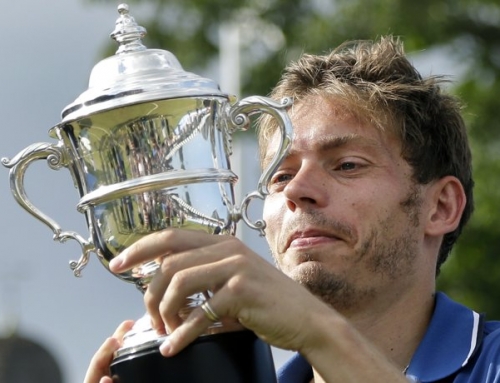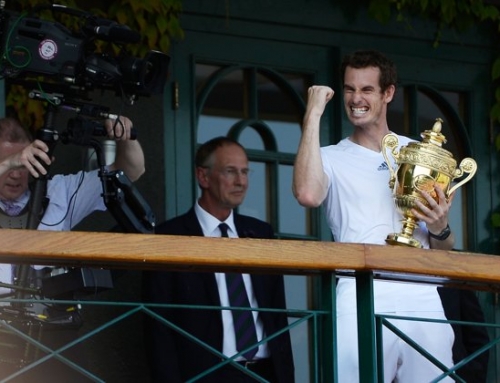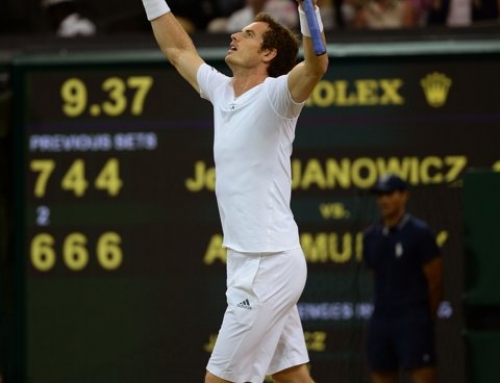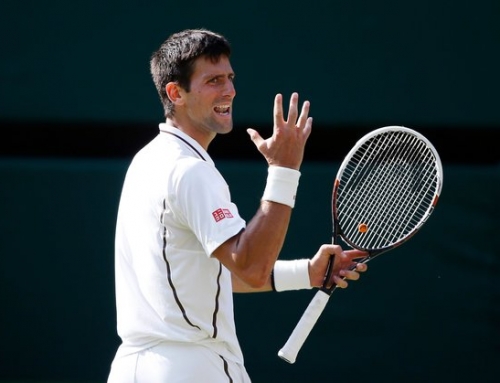 Murray looked like he had everything he needed. He was serving well, with first serve percentages near 70%, and impossibly high number for Murray who often sees 40% more than he sees 60%. He had his “Nadal strategy” in place, trying for big shots rather than the usual passive style he uses against most players.
Murray looked like he had everything he needed. He was serving well, with first serve percentages near 70%, and impossibly high number for Murray who often sees 40% more than he sees 60%. He had his “Nadal strategy” in place, trying for big shots rather than the usual passive style he uses against most players.
And, yet, Nadal being Nadal, made Murray’s job tough, by holding on his own serve. Nadal can often get into a passive mode, where he feeds loopy balls up the center and doesn’t take many risks. By doing this, he let Murray dictate play in their previous encounters. This time, Nadal wanted to take more risks, to aim for the lines more.
Murray was trying to play loopers to the Nadal backhand, and then play a hard down-the-line forehand. As usual, when someone plays a “Nadal strategy”, that is when they try to hit hard and overpower Nadal, they leave themselves open to unforced errors. And ultimately, that tends to do them in. When Nadal goes for bigger shots, he has such great topspin and he is such an accurate hitter, that he makes his hard shots with few errors. That’s the genius of Nadal. When he wants to up the level of his game, he does so with almost no penalty. Everyone else finds themselves hitting more unforced errors.
Although this was a straight sets match, it was played at a pretty high quality. It didn’t have the nerves of the Djokovic match where Djokovic was just misfiring for no good reason where Murray was going for big shots when he missed. It’s just that Nadal puts so much pressure when you hit a weak shot, and he puts a lot of pressure even when you hit a pretty good shot.
The first serve percentage helped Murray out a great deal as he was able to get free points on his first serve. Nadal got a break in the first and took it 6-4. In the second set, both players held serve until the tiebreak. Although Rafa has a weaker serve, no pro has such a weak serve that you can consistently tee off on their second serves for winners. This isn’t the women’s game, after all.
So what do you do when you receive against Nadal? You can take a very conservative approach, a la Federer, who will slice a return in just to get the point started, or you can try to be more aggressive, like Murray was against Nadal, and miss more often when you play aggressive, but you hope, once a set, to get a key break, and hold on from there.
In the tiebreak, Murray started off ahead with a mini-break, but Rafa got the mini-break back quickly. With a double-fault from Nadal late in the tiebreak, Murray was up 6-5, serving for the second set. Although he had been serving at a high percentage the entire second set and had been hitting aces, he netted the first serve. By putting a second serve into play, he had to play a rally, one he eventually lost. Murray would then lose the next point, and Nadal would serve out the tiebreak, taking it 8 points to 6.
Murray seemed deflated. Should he have tried for a second serve ace? Perhaps Nadal would still have won in 4 sets. Given how Murray’s play really depended on a high first serve percentage, maybe it was a matter of time before Nadal would have beaten him anyway.
Surprisingly, Nadal had a bit of a lapse at the start of the third set, and got broken right away. This might have been the opening that Murray was looking for, but a bad thing happened to Murray. His first serve percentage plummeted. Serving nearly 70% in the first two sets, Murray’s first serve percentage took a dive and was barely above 40%. This meant Nadal had more opportunities to get into rallies. Without a few free points on his own serve, Murray struggled to hold serve.
Although he held for a few service games, Murray eventually lost his break lead, and then, when Nadal got up 5-4 and Murray had to serve to stay in the match, Nadal again got break points. As with many players down match point, Murray decided to go to net to force the issue. A high floaty passing shot lead to a Murray swinging volley which landed just deep, and gave Nadal not only the break, but the match.
Ultimately, Murray didn’t play a bad match, but to play such an aggressive style is often so contradictory to what most players do that they can’t both hit hard and hit accurately. Players like del Potro hit huge shots but it’s within the scope of what they do. They aren’t pressing, trying to hit great shots. Similarly, when Davydenko plays Nadal, he doesn’t try to do things differently. He knows his style, as is, can beat Nadal. He just has to execute.
Nadal, for his part, played very aggressively. This has been a shift from how he used to play, and he may be looking to play this style more often, so that he puts his opponents under even more pressure than usual. Nadal also made judicious use of the slice backhand, keeping the ball low. When Murray tried the same, Nadal was determined to run around it. Imagine that. Murray is hitting a slice backhand down the line to the Nadal backhand. Nadal recognizes the slice, and runs around the backhand to hit a forehand! Even 10 years ago, the idea of doing this would be borderline insane. For one, you have to recognize a slice, and for another, you have to really move your body around to hit that forehand, and then you have to hit that forehand.
One can imagine Ken Rosewall hitting his patented slice, only to see Nadal run around it, and hit an inside out power forehand. He would have wondered what planet Nadal came from!
Nadal also did a great job of improvising. When Murray would hit an odd shot and something awkward, Nadal would find ways of getting the ball back. Murray hit an aggressive return that landed near the baseline. Nadal hit a quick swing that lead to a floaty return, but it was deep enough that Murray couldn’t take advantage. There were points like this, or points where Nadal made some nice volleys, that prevented Murray from getting a foothold in the match.
Now, Nadal meets Berdych in the finals. Berdych is a bit like Soderling. Huge serve. Unlike Soderling, Berdych’s first serve percentage isn’t that high, usually between 50% and 60%. However, Berdych has a nice power crosscourt forehand and hits an inside-in and inside-out forehand as well as anyone. He has such a smooth, relaxed motion that sometimes opponents are shocked at the speed at which it comes.
Nadal will be heavily favored to win the final, so one wonders if Berdych’s calm demeanor will give Nadal some trouble or not. Berdych’s main advantage over Murray is that he, like Soderling, hits hard naturally. But like Soderling, Berdych isn’t a fantastic mover. He probably moves just a bit better than Soderling, so that should help. Nadal will make Berdych’s life tough by getting to ball after ball and presumably by trying to be aggressive like he was against Murray. One hopes that Berdych can play great tennis and give us a great final, one way or the other, but the odds don’t favor it.







